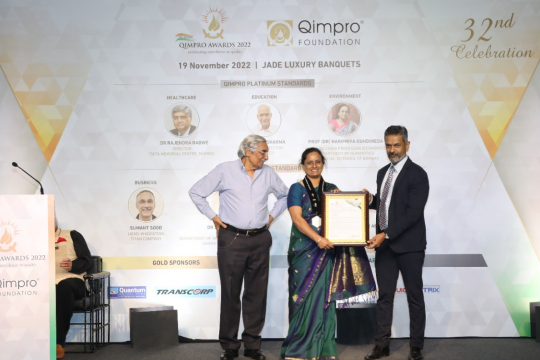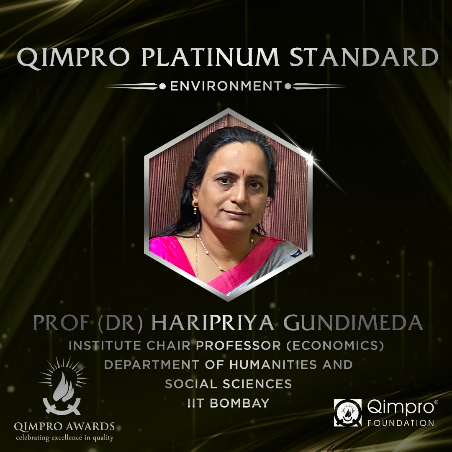EfD researcher Haripriya Gundimeda Professor at the Indian Institute of Technology (IIT) Bombay has been awarded the Qimpro Platinum Standard 2022 award under the category Environment. The Quimpro Foundation recognizes quality leaders in environment and other categories. Haripriya Gundimeda has had an important role in implementing green accounting in India, among many other things.
In the past, eminent personalities like Justice M. C. Mehta, who won a lot of environmental battles for India through his judgments, and Bittu Sehgal, editor of Sanctuary magazine have received the award in the category of environment. The award ceremony took place on 19 November 2022. EfD India had the opportunity to interview her to discuss this award.
How do you feel after being recognized by this prestigious award?
Even when my name was nominated, I felt very humbled and at the same time privileged, especially when I saw some of the previous recipients of this award. I also felt that I am once again being reminded of my responsibilities towards the environment and sustainable development.
Can you briefly describe the history of this award?
Qimpro awards are recognized as the country’s premier quality citations, instituted with an aim to recognize individual excellence in quality management. The foundation recognizes quality Statesmen with the Qimpro Platinum Standard and Quality Leaders with Qimpro Gold Standard – in business, healthcare, education, and the environment. The winners are selected by four panels of judges; each chaired by the respective Qimpro Platinum Standard of the previous year. To be eligible for the award, the individual should 1) be a national statesman for quality and excellence; 2) have a bold quality and excellence vision for India, 3) have a sterling track record for ethics, governance, and social responsibility, and 4) be an inspiration for the youth in India and overseas. In the category of environment, I am only the third recipient of this award.
What drew you to the environment before you pursued research?
I was first introduced to Natural Resources Accounting in a program called Environment Management for Capacity Building in 1997 when I joined the Indira Gandhi Institute of Development Research (IGIDR). The disparities in the way we treat manufactured or produced capital and environmental capital got me immersed in the area of Environmental Accounting for research. It was then that I understood: To incorporate one resource into the national accounting system, one needs to understand the entire linkage of the resource with the macroeconomy.
What got you interested in modeling ecosystem services and human welfare?
When I decided to work in a nascent area of environmental accounting, data availability was a major challenge. I chose to do forest resources accounts, the only resource that seemed to have some data. At that time, the Kyoto Deal was signed and so I wanted to link forests to Kyoto. Hence, I looked at the carbon sequestration potential of forests in India and modeled the carbon budget by Indian forests. For this, it was needed to estimate the biomass potential, which I did through various forest inventories. After publishing my thesis, we then went ahead with a group to develop green national accounts for all the states in India using a consistent framework and also adjust the national accounts, under the guidance of the Green Accounting for Indian States Project.
One obvious offshoot of the work was estimating the value of biodiversity in Indian forests. In 2005 Millennium Ecosystem Services Assessment (MEA) was published and the System of National Accounts (SNA) was revised around this to develop a Satellite system of Environmental Accounts. So, my focus shifted to thinking along the lines of MEA services.
In 2007, the G8+5 environment ministers commissioned a study on estimating the economic value of loss of biodiversity to welfare. The study on The Economics of Ecosystems and Biodiversity (TEEB) had been conceptualized and I got deeply involved in the interim report and later as a Coordinator for TEEB for local and regional policymakers.
Can you summarize your current research and how it evolved over time?
Though my work interfaces with environment and development, I continue to work in the area of natural capital accounting, valuation of biodiversity and ecosystem services, climate change adaptation, and valuation of agricultural externalities. My past research has been foundational to my current work. I worked on green accounting for Indian states, then shifted my focus to assessing the energy demand models using household data, and to the economics of ecosystems and biodiversity project. As TEEB made an international imprint, the national governments got interested in implementing country-level studies. I have been part of the TEEB India Initiative where we carried out a study on estimating the economic value of ecological services provided by the western ghats. Thereafter, as a part of the UNEP initiative, I got involved with the TEEB agri-food complexes, where we highlighted the value of externalities caused by our agriculture and food systems. Simultaneously, I was involved in various projects like the Economic valuation of Sanjay Gandhi National Park in Mumbai, Assessing the macroeconomic impacts of biofuels on the Indian economy, Estimating the value of social capital created by the Natural Community farming project in Andhra Pradesh, Estimating the adaptation costs of climate change on water resources, etc.
How will this prestigious award benefit your cause and research?
I am quite happy that the foundation, which already recognized the three capitals – i.e. manufacturing, health, and finance, has now recognized that the fourth foundation pillar i.e. the natural capital is just as important for well-being; which is an important step in the right direction. For a researcher, recognition generates the requisite momentum to push forward. As part of the TEEB study, we showed the interdependencies between industry and biodiversity, highlighting the benefits and impacts. I would like to see how we can work in collaboration and draw synergies. I feel, there is a lot we can do on issues such as internalizing externalities, carbon pricing, renewable energy, no net loss to society, etc. I am sure, something mutually interesting would be worked out in the near future.
How can India’s industry-academia nexus help in achieving SDGs?
In India, to achieve the SDGs, there is a lot that industry and academic researchers can collaborate on to address issues of common interest. Innovation comes through research from academia and if the industry adopts them, a lot can be achieved. The 1990s witnessed the outbreak of a movement and now we are in the take-off phase after three decades. It has now become even more important for industry and academia to collaborate so that industry becomes one of the key users of the knowledge that we generate. Rather than saying industrial activities are the key generators of pollution, we should generate new ideas, which, when incorporated would generate win-win solutions.
Being a member of the CECFEE and EfD network, how do you envisage that your award will encourage other young researchers within the network?
EfD researchers have been working on policy-relevant issues in this area for a while now and these aim to contribute to the current environment-economy-industry policy debate. Now that the industries are realizing that the environment too is one of the prime pillars for business, EfD researchers can collaborate on issues relevant to the industry. I envisage that other young researchers identify ideas that generate mutually beneficial solutions at the least cost to industries as well as society.
How do you foresee your future prospects in strengthening the relationship between the industry’s R&D and environment-development policymakers?
I foresee industry playing a big role as they start internalizing the externalities and also, more research in this area to help address this desired structural change. Decarbonization is an example of structural change which happened as a result of years of extensive research by academia. The Green rating project is another example of trying to fix the asymmetric information problem. Environment, Social, and Governance (ESG) is another such example.
What lies ahead for you as a researcher and an educator?
I plan to work on issues leading to a sustainable environment. I am more interested in solutions that are practical or those involved in behavior change of stakeholders to solve environmental problems. For example, the problem of chemical runoff from farms can be reduced, if people shift to producing food without using chemicals that harm the environment. The problems can also be solved by capacity building to generate enhanced environmental awareness. I would like to involve myself in the capacity building of youngsters to nudge them to adopt a sustainable lifestyle as well.
Any message for the EfD researchers in the network?
I follow the work of the members of the network, and I should say that they are all addressing imperative issues. All of them have a policy focus and in the upcoming years, I envisage the results will cascade down to society and industry. Research is incremental, and no academic research is worthless as it paves the way to generate innovative ideas for the future. Young researchers have a lot of opportunities now to put their research acumen into something which is well assimilated. Their focus should be on good work and eventually, the outputs of their research will be recognized. I am always keen to provide guidance and support whenever required.
By: Ishita Datta.

